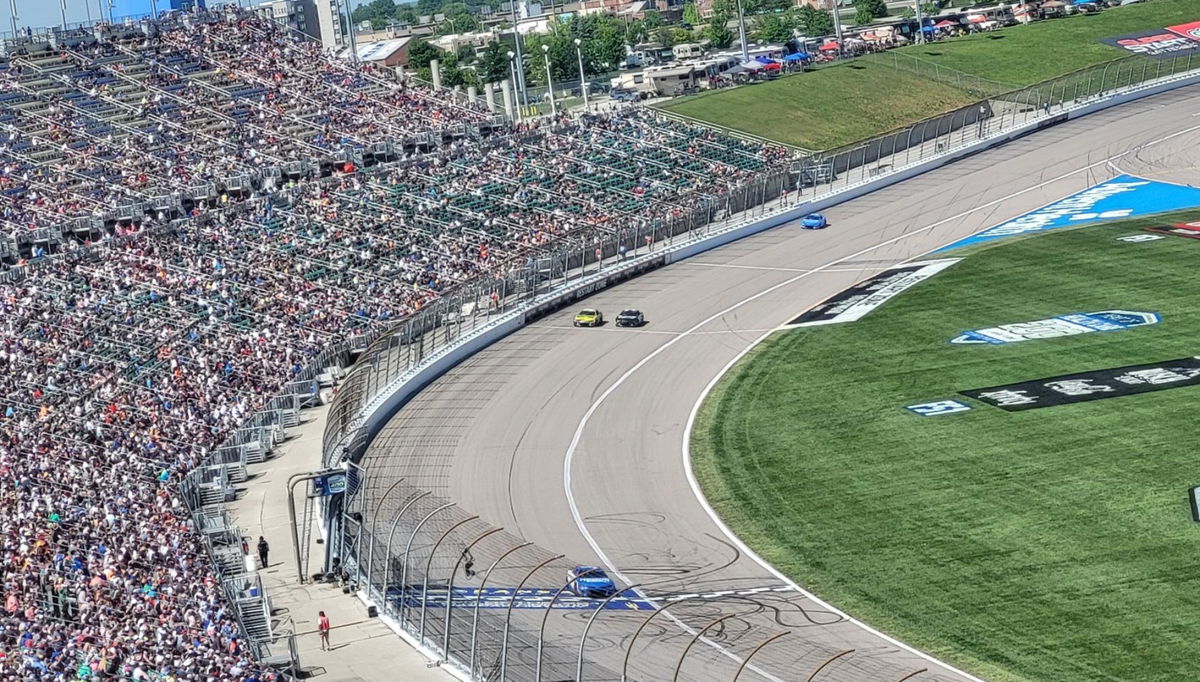
Imago
Image Credits – X

Imago
Image Credits – X
When the Daytona 500 attracted 6.7 million views despite a delayed start, there was a sense of excitement, a buzz that NASCAR just might be back on track. This sentiment grew louder when NASCAR’s Cup race at Texas beat Formula 1’s Miami Grand Prix with 2.56 million viewers. As good as these numbers might look, there’s a concern that isn’t getting recognized in the grand scheme of things. The decline in attendance from the fans visiting the races is indeed worrisome, and that was evident during Sunday’s race at Kansas Speedway.
Watch What’s Trending Now!
Even Kyle Larson’s sheer brilliance or the star appeal wasn’t enough to lure in the fans to witness the best racing product the premier stock car series has to offer. As Larson got out of his race car after leading 221 of 267 laps, he was cheered on by the half-filled rows of fans in the grandstands. An argument can be made that it was the Mother’s Day weekend, and fans decided to stay home rather than visit the race. But this issue seems deeper than it might look on the surface.
Fans on social media didn’t mince their words, seeing how empty the seats were while Larson was leaving his competition in the dust. “NASCAR spent a year reliving the closest finish in NASCAR history from last year’s spring Kansas race and there were empty seats in today’s race?!? Wow. NASCAR is in real trouble.” From a record-breaking closest finish last year to a one-sided affair this year, fans couldn’t decode the real reason behind the lack of attendance. But this wasn’t just a random occurrence, as NASCAR has been dealing with this issue for some time now.
ADVERTISEMENT
The people who love this sport said it best. NASCAR insider Jordan Bianchi, watching from the press box, didn’t sugarcoat it: “I really can’t say on what I saw with my own eyes,” Bianchi started about the similar situation at Miami-Homestead last year. “But the conversation I’ve had with people it did not sound good today. I knew going in it wasn’t going to be great. There was actually more walk-up today than they anticipated, so that’s encouraging.” Although the parity racing and the Next Gen car often end being on the receiving end of the stick, there’s more to the attendance issue than just the racing product.
The racing itself isn’t the problem. Kansas delivered a thriller, and drivers like Larson, Denny Hamlin, and Chase Elliott are still putting on a show. But the barriers to showing up are piling up. Ticket prices are a huge hurdle. “I’d love to take my kids to a race, but $120 a seat? That’s a car payment,” one fan commented on X. The economy doesn’t help—gas, hotels, and food for a race weekend add up fast, and with inflation squeezing wallets, families are cutting back. “I used to go to Bristol every year,” another fan wrote. “Now I’m lucky if I can afford one race every five.”
Kyle Larson’s Kansas win in front of a bunch of empty seats exemplifies NASCAR’s fundamental problem: If the stands are half-full at NASCAR’s best track, how can the sanctioning body claim everything is OK?https://t.co/BwsNnJeVIT
— Nick Bromberg (@NickBromberg) May 11, 2025
ADVERTISEMENT
Then there’s the way we consume sports today. Streaming services, YouTube highlights, and social media clips mean you can catch every wreck and pass without leaving your couch. Why spend hundreds when you can watch for free? But it’s not just convenience. NASCAR’s fan base is changing, and the sport hasn’t kept up. Younger fans want more than racing—they want an experience, something to post on Instagram or TikTok. Tracks like Homestead and Martinsville are legendary, but they’re not music festivals or esports arenas.
There needs to be a conscious effort on NASCAR’s end to ensure that prominent tracks do not lose their luster. 1.5-mile tracks have provided the best racing action in the Next Gen era, so a track like Kansas failing to pull in the crowds is indeed worrisome. If this issue isn’t resolved, we might see Kansas end up getting sidelined, and we’ve seen prominent tracks getting snubbed because of the lack of attendance, or NASCAR’s ambitious moves.
ADVERTISEMENT
Kansas could receive the Richmond treatment
NASCAR is in a transition phase with its primary objective to attract a new audience to the sport. Yeah sure, they’ve added Bowman Gray Stadium and North Wilkesboro back on the schedule, but these are special events and not points-paying races. We have seen NASCAR go from two odd road course races to five in a calendar year. In 2025, we will have an international race in Mexico City on a road course layout, and there’s another trip to the Windy City to race in the streets of a metropolitan area.
Now, this international race and retention of the street race event didn’t come free. In fact, NASCAR decided to snub the Richmond Raceway, a traditional short track, to accommodate these ambitious adventures. So you see, there’s a trend emerging here, a track that does not produce thrilling races or has seen a decline in attendance gets replaced by NASCAR’s ambitious drive. It has to be noted that while Homestead Miami Speedway will return with the championship weekend, it will only have one race next year. Whereas, Phoenix Raceway will retain two races on the schedule, despite losing out on the blockbuster finale.
ADVERTISEMENT
If anything, NASCAR will need to do something about the racing product at Kansas or offer something more than just racing. At this rate, they are slowly pushing the venue towards its inevitable end, which will not be received well by the majority of the NASCAR fanbase.
ADVERTISEMENT
ADVERTISEMENT
ADVERTISEMENT

